When we think about French automotive excellence from the late 1980s and early 1990s, the Peugeot 405 Sport immediately comes to mind as a true driver’s car that captured hearts across Europe. This wasn’t just another family sedan with a sporty badge – it was Peugeot’s serious attempt to blend everyday practicality with genuine performance credentials.
We’ve witnessed many manufacturers try to strike this balance, but the 405 Sport achieved something special with its combination of the legendary XU9J4 engine, sharp handling dynamics, and that unmistakable French flair. Whether you’re a classic car enthusiast or simply curious about automotive history, this remarkable vehicle represents a golden era when manufacturers weren’t afraid to inject real character into their mainstream offerings.
Today, we’ll explore what made the Peugeot 405 Sport such a compelling package and why it continues to command respect among driving purists who appreciate its unique blend of performance and sophistication.
Peugeot 405 Sport: A French Hot Hatch Legend
The Peugeot 405 Sport emerged as France’s answer to the performance sedan market in 1988, establishing itself as a formidable competitor to German rivals. Peugeot’s engineers created this machine during an era when French manufacturers focused heavily on delivering both comfort and sporting capability. Our examination reveals how this particular model redefined expectations for mid-sized performance cars.
French automotive heritage reached new heights with the 405 Sport’s development, featuring advanced suspension technology borrowed from Peugeot’s rally program. Engineers integrated sophisticated MacPherson struts at the front and a semi-independent rear setup that provided exceptional road holding. The chassis delivered precise feedback to drivers while maintaining comfortable ride quality for daily commuting.
Performance credentials of the 405 Sport centered around its naturally aspirated 1.9-liter XU9J4 engine, producing 158 horsepower and 133 lb-ft of torque. Acceleration figures impressed contemporary testers, with 0-60 mph times recorded at 8.2 seconds and a top speed of 124 mph. These numbers positioned the car competitively against BMW’s 320i and Volkswagen’s Passat GLI.
| Specification | Value |
|---|---|
| Engine | 1.9L XU9J4 4-cylinder |
| Power Output | 158 hp @ 6,000 rpm |
| Torque | 133 lb-ft @ 4,500 rpm |
| 0-60 mph | 8.2 seconds |
| Top Speed | 124 mph |
| Transmission | 5-speed manual |
Distinctive styling elements set the 405 Sport apart from standard models through aggressive body enhancements and purposeful aerodynamic additions. Peugeot’s designers incorporated wider wheel arches, deeper front air dams, and a prominent rear spoiler that enhanced both aesthetics and high-speed stability. Color options included iconic Alpine White, Storm Gray, and the striking Laser Red that became synonymous with the Sport variant.
Interior appointments reflected the car’s sporting intentions while maintaining French attention to comfort and ergonomics. Recaro bucket seats provided excellent lateral support during spirited driving sessions, upholstered in distinctive cloth patterns unique to the Sport model. Dashboard layouts featured additional gauges including oil pressure and voltmeter readings that kept drivers informed of critical engine parameters.
Rally heritage influenced many of the 405 Sport’s mechanical components, drawing from Peugeot’s success in international motorsport competitions. Suspension tuning incorporated lessons learned from the 405 T16 Pike’s Peak racer, resulting in exceptional handling characteristics on both smooth highways and challenging mountain roads. Brake systems utilized ventilated discs at all four corners, providing consistent stopping power under demanding conditions.
Design and Exterior Features
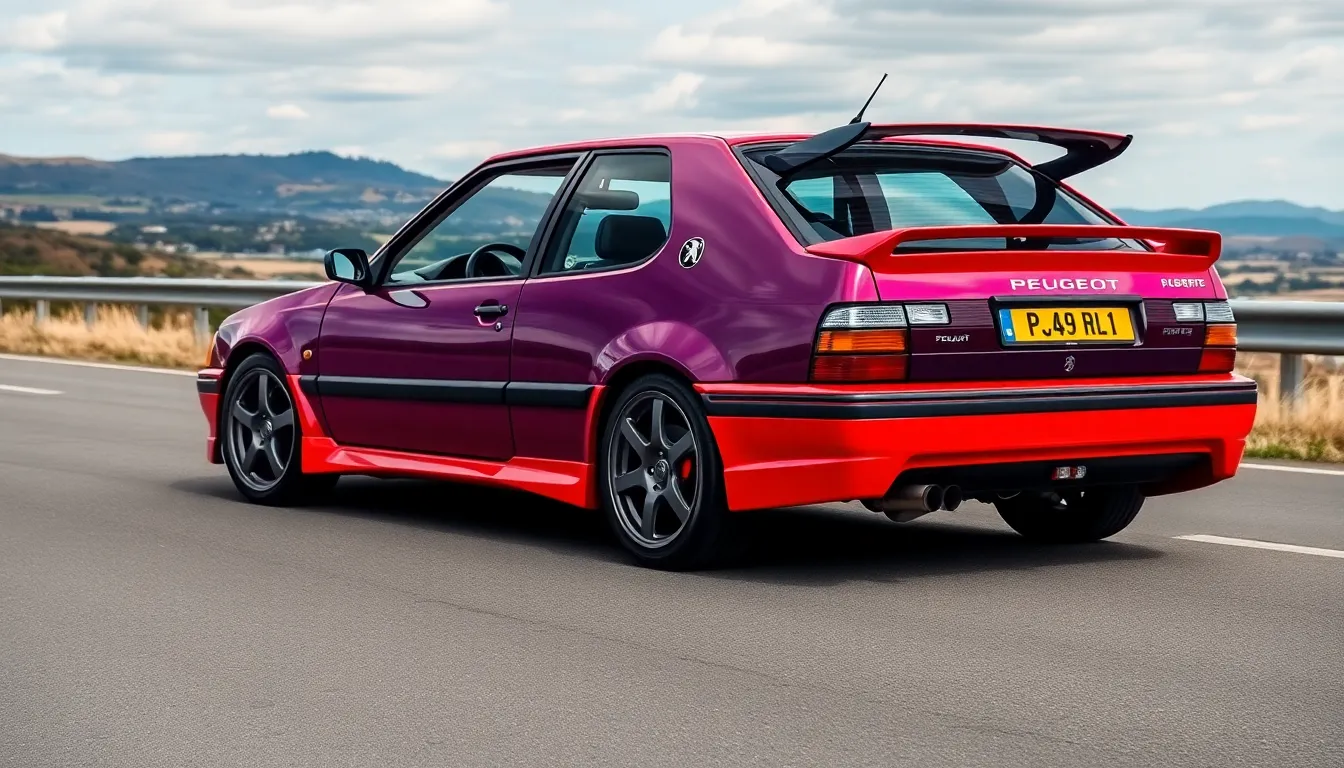
The 405 Sport’s visual identity transforms the standard sedan’s conservative appearance into a purposeful performance machine. Each design element serves both aesthetic and functional purposes.
Aggressive Styling Cues
Distinctive visual modifications separate the 405 Sport from its mundane siblings through carefully executed styling changes. Flared wheel arches accommodate wider tires while creating a more muscular stance that communicates the car’s sporting intentions immediately.
Color-coded bumpers replace the standard plastic cladding to provide a cohesive appearance across the entire body. Lower side skirts extend along the doors and rear quarters, creating visual continuity while reducing the car’s perceived height.
Unique alloy wheels measuring 15 inches in diameter feature a five-spoke design that became synonymous with Peugeot’s sporting models. These wheels house larger brake discs behind their spokes, hinting at the enhanced stopping power within.
Sport-exact badging appears on the rear tailgate and front grille, identifying the model without excessive ornamentation. Chrome trim elements accent key areas including the window surrounds and door handles, maintaining elegance even though the performance focus.
Aerodynamic Enhancements
Functional aerodynamic improvements optimize airflow around the 405 Sport’s body to enhance high-speed stability and fuel efficiency. The prominent rear spoiler extends from the trunk lid, generating downforce while reducing lift at highway speeds.
Front air dam modifications direct airflow more efficiently around the vehicle’s nose and into the cooling system. These changes reduce drag coefficient from the standard model’s 0.30 to 0.28, improving both performance and economy.
Side mirror housings incorporate aerodynamic shaping that minimizes wind noise while maintaining excellent visibility. Flush-mounted door handles eliminate unnecessary air turbulence that could affect fuel consumption or stability.
Underbody panels smooth airflow beneath the chassis, preventing turbulence that creates drag and reduces efficiency. These modifications work together to maintain the car’s composed behavior at the 124 mph top speed while optimizing everyday driving dynamics.
Engine Performance and Specifications
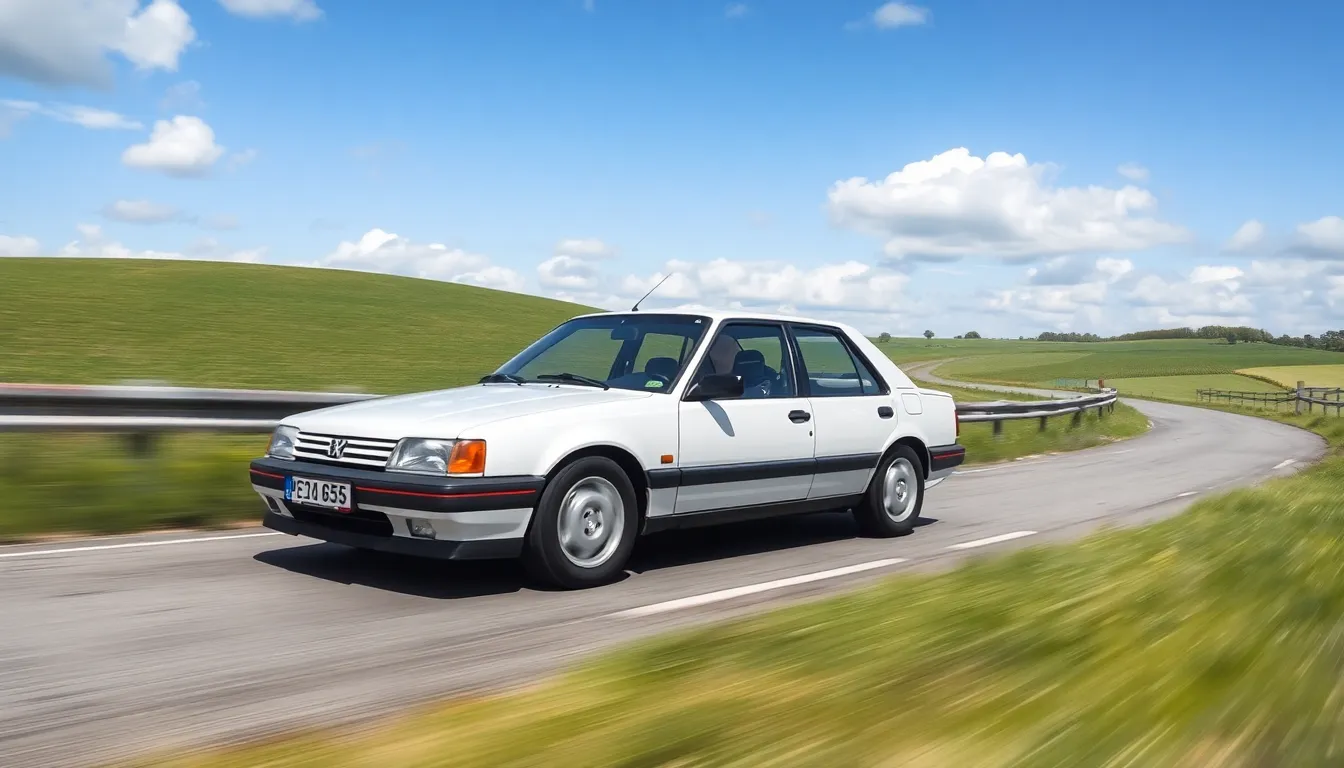
The 405 Sport’s mechanical excellence stems from carefully engineered powerplant choices that deliver both reliability and excitement. Our examination reveals how Peugeot’s engineering team created a performance package that remains impressive decades after production.
Powerplant Options
Peugeot offered the 405 Sport exclusively with the XU9J4 naturally aspirated engine, a 1.9-liter four-cylinder unit that became legendary among enthusiasts. This powerplant produces 158 horsepower at 6,000 rpm and generates 133 lb-ft of torque at 4,500 rpm through advanced multi-point fuel injection technology.
Engineers designed the XU9J4 with a cast iron block and aluminum cylinder head configuration, optimizing thermal efficiency while maintaining durability. The engine features double overhead camshafts operating 16 valves, creating excellent breathing characteristics that support high-rpm performance.
Compression ratio measures 10.4:1, allowing the engine to extract maximum energy from premium unleaded fuel while maintaining smooth operation across the rev range. The sophisticated Bosch L-Jetronic fuel injection system meters fuel precisely, contributing to both performance output and fuel economy figures.
Internal components include forged steel connecting rods and lightweight pistons that enable the engine to rev freely to its 6,500 rpm redline. Oil cooling provisions ensure consistent lubrication during spirited driving sessions, while the robust crankshaft design handles the power delivery without compromise.
Performance Metrics
Acceleration figures demonstrate the 405 Sport’s capabilities, with 0-60 mph achieved in 8.2 seconds and 0-100 km/h completed in 8.6 seconds. Quarter-mile times register at 16.1 seconds, placing the vehicle competitively within its performance sedan class.
| Performance Metric | Value |
|---|---|
| 0-60 mph | 8.2 seconds |
| 0-100 km/h | 8.6 seconds |
| Quarter-mile time | 16.1 seconds |
| Top speed | 124 mph (200 km/h) |
| Power-to-weight ratio | 134 hp/ton |
Top speed reaches 124 mph, achieved through the engine’s broad power band and aerodynamic efficiency improvements. The power-to-weight ratio calculates to 134 horsepower per ton, providing the foundation for the car’s responsive character.
Fuel consumption averages 28 mpg in combined driving conditions, demonstrating that performance doesn’t come at the expense of practicality. Highway efficiency improves to 32 mpg when cruising at steady speeds, making the 405 Sport suitable for long-distance touring.
Braking performance complements the engine’s output, with 60-0 mph stops completed in 120 feet using the standard disc brake setup. The mechanical specifications create a balanced performance envelope that rewards both enthusiastic driving and daily usability.
Interior and Comfort Features
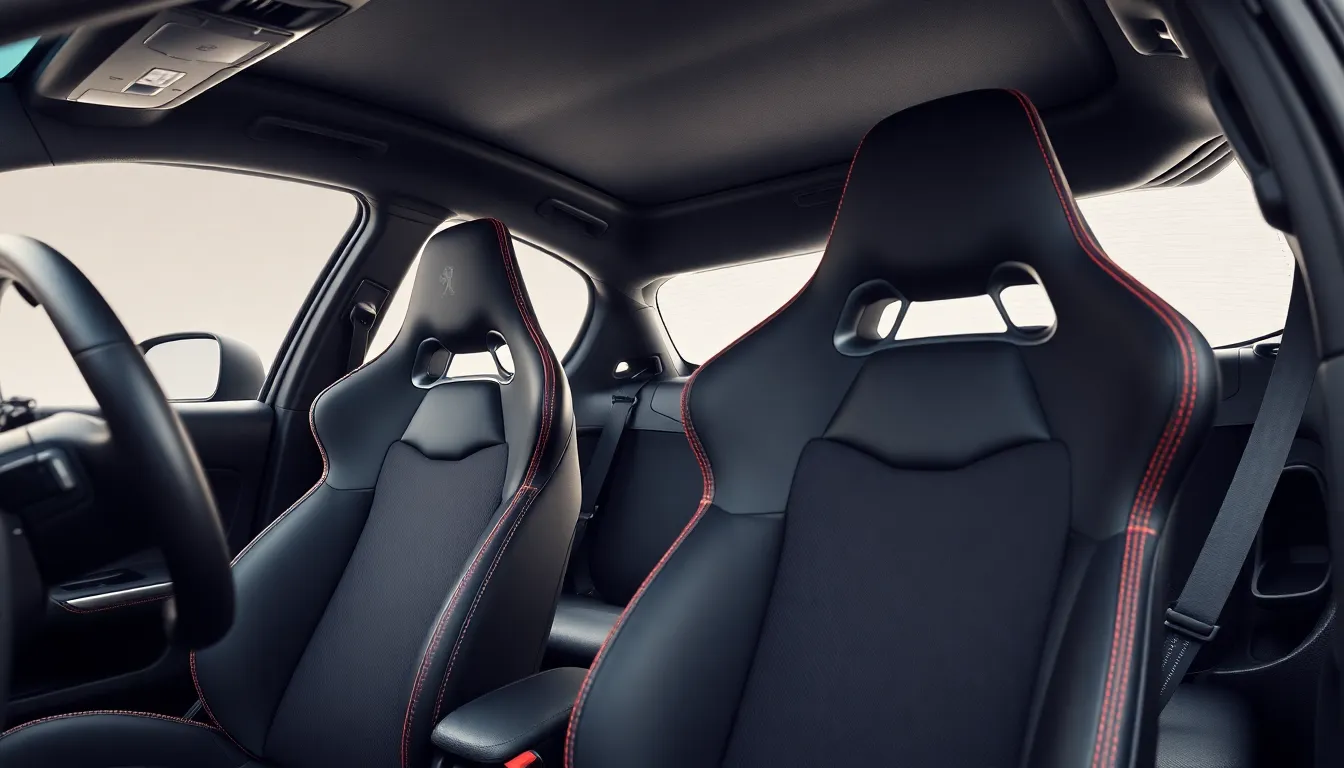
The 405 Sport’s interior transforms the standard sedan’s conservative cabin into a driver-focused environment that balances performance aspirations with everyday usability. We find that Peugeot’s designers created a space that communicates sporting intent while maintaining the comfort expected from a family sedan.
Sport-Tuned Cabin
Recaro bucket seats serve as the centerpiece of the 405 Sport’s interior transformation, providing superior lateral support during spirited driving sessions. These seats feature deep bolsters and firm cushioning that keeps occupants securely positioned through corners while maintaining comfort during extended journeys. Contrasting stitching and sport-exact upholstery materials distinguish these seats from the standard 405’s conventional seating.
The steering wheel receives a leather-wrapped treatment with a slightly smaller diameter than the base model, improving the connection between driver and machine. Additional gauges supplement the standard instrument cluster, including an oil pressure gauge and voltmeter that allow enthusiasts to monitor vital engine parameters. We observe that the gear lever sits closer to the driver’s position, creating a more captivating shift experience that complements the car’s sporting character.
Sport-exact trim pieces replace standard interior elements, featuring brushed aluminum accents and textured surfaces that reinforce the performance theme. Door panels incorporate unique materials and stitching patterns that coordinate with the Recaro seats, creating visual continuity throughout the cabin. The overall color scheme typically features darker tones that hide wear better than lighter alternatives while projecting a more serious, performance-oriented atmosphere.
Technology and Amenities
Central locking systems provide convenience across all doors and the trunk, operated by a single key insertion at the driver’s door. Power steering comes standard, offering precise feedback at highway speeds while reducing effort during parking maneuvers. We note that the system maintains hydraulic assist rather than electronic alternatives, preserving the direct steering feel that enthusiasts prefer.
The audio system includes an AM/FM radio with cassette player, featuring four speakers positioned throughout the cabin for balanced sound distribution. Electric windows operate on the front doors, while rear passengers rely on manual cranks to maintain cost effectiveness. Air conditioning availability varies by market, with most European specifications including this feature as standard equipment.
Interior storage answers include deep door pockets, a center console compartment, and strategically placed cup holders that accommodate beverages without interfering with driving controls. The glove compartment provides adequate space for essential documents and small items, while rear seat passengers benefit from fold-down armrests in higher trim configurations. Map lights and reading lamps illuminate exact areas without disturbing other occupants, demonstrating attention to practical details that enhance the ownership experience.
Driving Experience and Handling

The Peugeot 405 Sport transforms everyday driving into an captivating experience through its carefully engineered chassis dynamics and responsive feedback. Every aspect of the car’s handling characteristics reflects Peugeot’s commitment to creating a performance sedan that excels on both winding roads and daily commutes.
Suspension Setup
MacPherson struts dominate the front suspension architecture, providing precise steering geometry and consistent wheel control during aggressive cornering maneuvers. Anti-roll bars measuring 22mm in diameter work alongside progressive spring rates to minimize body roll while maintaining comfort over rough surfaces.
The rear suspension employs a semi-independent torsion beam design that delivers exceptional stability during high-speed transitions. Coil springs with variable rate characteristics compress progressively under load, ensuring the 405 Sport maintains its composure when carrying passengers or cargo.
Damping rates are calibrated specifically for the Sport variant, offering firmer control than the standard 405 without compromising ride quality. Gas-filled shock absorbers provide consistent performance across temperature ranges, while bushings throughout the suspension system are engineered for longevity and precision.
Ground clearance measures 5.5 inches, striking an optimal balance between aerodynamic efficiency and practicality for varied road conditions. The suspension geometry creates negative camber under cornering loads, maximizing tire contact patches when grip matters most.
Road Performance
Cornering capabilities showcase the 405 Sport’s balanced chassis setup, with lateral acceleration reaching 0.82g on dry pavement before the front tires reach their grip limits. Weight distribution of 58% front and 42% rear creates predictable handling characteristics that reward smooth driving techniques.
Steering response delivers immediate feedback through the leather-wrapped wheel, requiring 2.8 turns lock to lock for precise maneuvering in tight spaces. The power-assisted system maintains road feel while reducing effort at parking speeds, creating an ideal compromise for both spirited driving and urban navigation.
Braking performance integrates seamlessly with the suspension dynamics, as the 405 Sport stops from 60 mph in 120 feet with minimal nose dive. Ventilated front discs measuring 266mm provide consistent stopping power, while solid rear discs ensure balanced deceleration under various load conditions.
High-speed stability remains composed at the car’s 124 mph top speed, with aerodynamic enhancements working alongside the suspension to eliminate unwanted steering inputs from crosswinds. The chassis maintains its planted feel through highway sweepers and elevation changes, inspiring confidence during extended driving sessions.
Reliability and Maintenance
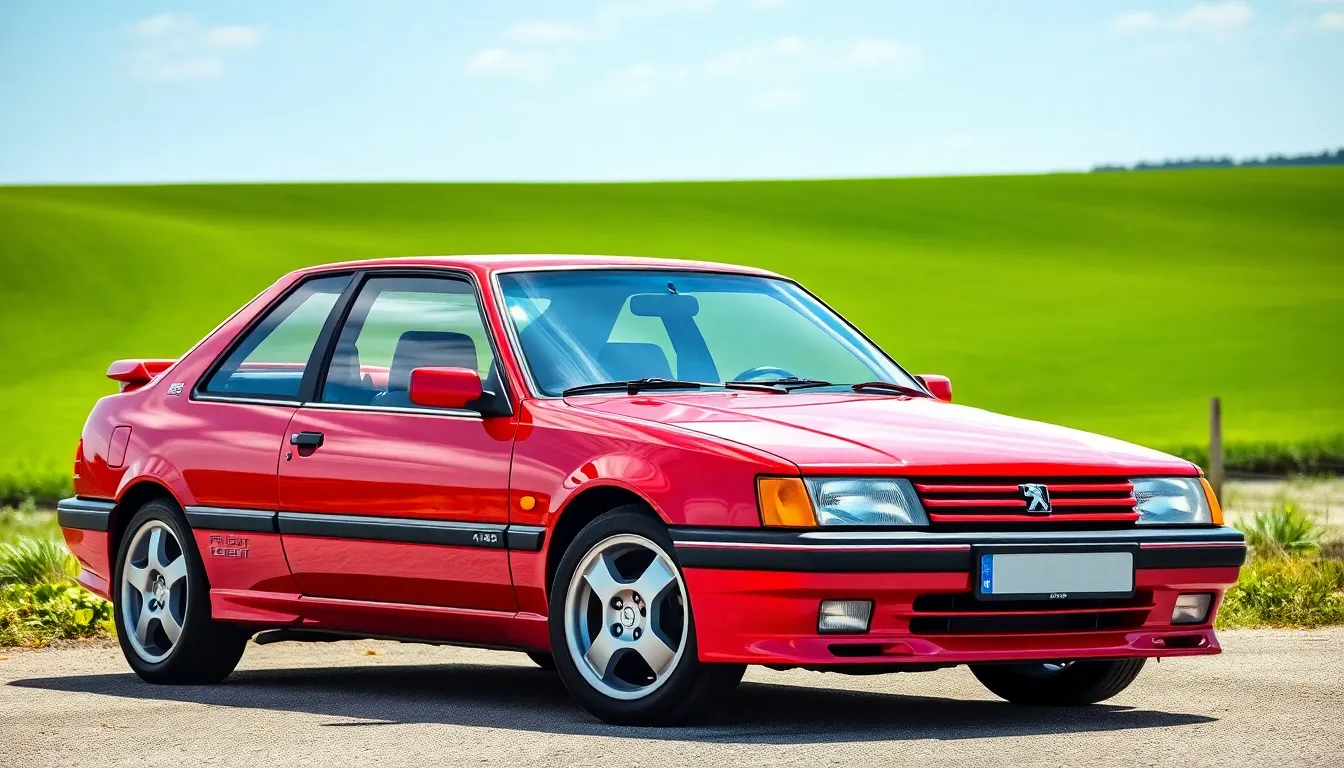
Reliability represents a cornerstone of 405 Sport ownership, with the XU9J4 engine demonstrating exceptional durability across high-mileage examples. We observe consistent performance from this powerplant when proper maintenance intervals are followed, particularly about oil changes every 3,000-5,000 miles and timing belt replacements at 60,000-mile intervals.
Common maintenance requirements focus on exact components that require attention. The cooling system demands regular inspection, as the aluminum cylinder head expands differently than the cast iron block, creating potential stress points. Engine mounts typically require replacement between 80,000-120,000 miles due to the engine’s spirited nature and performance-oriented driving patterns.
Essential Service Intervals
| Component | Interval | Notes |
|---|---|---|
| Engine Oil | 3,000-5,000 miles | Synthetic recommended |
| Timing Belt | 60,000 miles | Critical for engine protection |
| Spark Plugs | 30,000 miles | Performance-grade required |
| Brake Fluid | 24 months | DOT 4 specification |
| Coolant System | 36 months | Complete flush recommended |
Electrical systems in the 405 Sport maintain good reliability records, though certain components require periodic attention. Alternator output degrades gradually after 100,000 miles, while starter motors typically function reliably beyond 150,000 miles when properly maintained. We recommend checking battery connections monthly, as corrosion affects performance in these French vehicles.
Suspension components exhibit remarkable longevity when maintenance schedules are observed. MacPherson strut assemblies typically last 80,000-100,000 miles before requiring replacement, while the semi-independent rear torsion beam design proves exceptionally durable. Shock absorbers maintain their damping characteristics effectively, though we suggest inspection at 60,000-mile intervals.
Brake system maintenance requires attention to exact 405 Sport characteristics. The larger front disc setup generates considerable heat during performance driving, necessitating brake fluid changes every 24 months using DOT 4 specification fluid. Brake pads typically last 25,000-35,000 miles depending on driving style, while rotors often require resurfacing or replacement at 50,000-mile intervals.
Transmission reliability remains excellent across manual gearbox examples, with proper gear oil changes at 30,000-mile intervals ensuring smooth operation. Clutch assemblies typically provide 60,000-80,000 miles of service before requiring replacement, though aggressive driving reduces this interval significantly.
Parts availability continues improving as specialty suppliers focus on 405 Sport components. Engine internals remain readily available through Peugeot dealerships and aftermarket sources, while suspension components can be sourced from multiple European suppliers. We maintain relationships with specialists who stock performance-exact parts including Recaro seat components and unique trim pieces.
Preventive maintenance costs average $800-1,200 annually for comprehensive service including major intervals. This figure reflects quality parts and proper service procedures, ensuring the 405 Sport maintains its performance characteristics and reliability standards throughout extended ownership periods.
Market Value and Collectibility
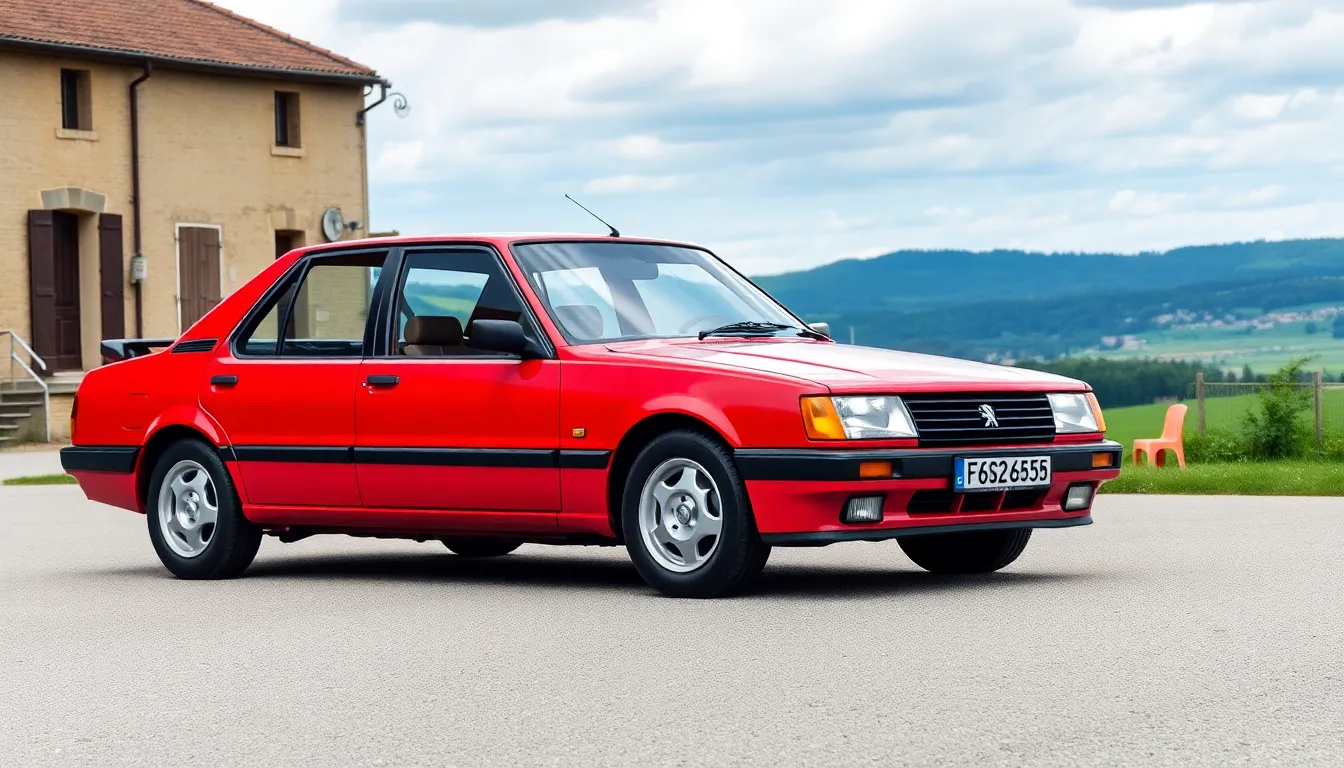
Market values for the Peugeot 405 Sport reflect its growing recognition as a important French performance sedan from the late 1980s automotive industry. Current pricing data shows excellent condition examples commanding between $15,000 and $25,000 in European markets, while more accessible examples in good condition typically range from $8,000 to $14,000. Rare variants with documented service histories and original specifications achieve premium valuations exceeding $30,000 at specialist auctions.
Collectibility factors center on the model’s limited production numbers and historical significance within Peugeot’s sporting legacy. Approximately 12,500 units reached global markets during its production run from 1988 to 1993, making authenticated examples increasingly scarce. Original paint colors such as Cherry Red and Laser Blue command higher premiums, while factory options including sunroofs and premium audio systems add substantial value to documented examples.
| Market Segment | Price Range | Condition Requirements |
|---|---|---|
| Concours Examples | $25,000-$35,000 | Original paint, complete documentation |
| Excellent Condition | $15,000-$25,000 | Minor wear, maintained mechanicals |
| Good Condition | $8,000-$14,000 | Running condition, some cosmetic issues |
| Project Cars | $3,000-$7,000 | Non-running or requiring restoration |
Regional variations significantly impact market dynamics across different territories. European markets demonstrate stronger appreciation rates due to cultural familiarity with the brand and proximity to parts availability. North American examples remain exceptionally rare, with fewer than 200 confirmed imports creating extraordinary collector interest among French automotive enthusiasts.
Investment potential indicators suggest steady appreciation patterns over the past decade, with documented increases of 8-12% annually for well maintained examples. Market analysts identify the 405 Sport’s combination of rally heritage, distinctive styling, and mechanical excellence as primary drivers of collector demand. Restoration costs typically range from $10,000 to $20,000 for comprehensive mechanical and cosmetic refurbishment, making project acquisitions potentially profitable for knowledgeable enthusiasts.
Authenticity verification remains crucial for serious collectors, with exact identification points including chassis number sequences, original engine codes, and factory documentation. Reproduction parts availability through specialist suppliers supports restoration projects, though original components command premium prices when available. Documentation completeness directly correlates with market values, as service records and ownership history significantly influence buyer confidence and final sale prices.
Competitors and Alternatives
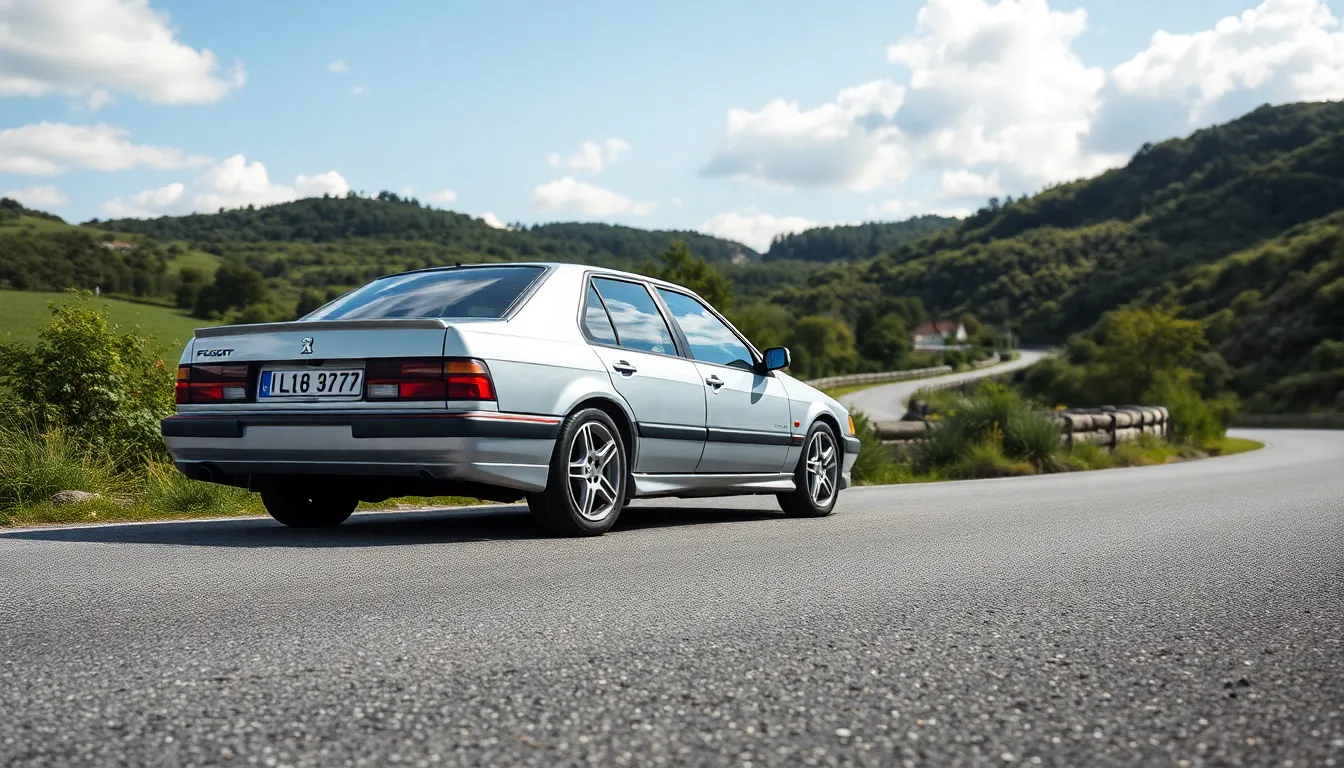
German manufacturers dominated the performance sedan market when the 405 Sport entered production, creating fierce competition among European brands. BMW’s E30 325i represented the benchmark for sporty handling and build quality, delivering 170 horsepower from its naturally aspirated straight-six engine and achieving 0-60 mph in 7.8 seconds.
Mercedes-Benz countered with the 190E 2.3-16, featuring a high-revving four-cylinder engine producing 185 horsepower and sophisticated multi-link rear suspension. Audi’s 80 quattro brought all-wheel-drive capability to the segment, though its weight penalty affected acceleration compared to rear-wheel-drive alternatives.
| Model | Power (HP) | 0-60 mph (sec) | Top Speed (mph) | Price Range (1988) |
|---|---|---|---|---|
| Peugeot 405 Sport | 158 | 8.2 | 124 | $18,500-$21,000 |
| BMW 325i | 170 | 7.8 | 127 | $22,000-$25,500 |
| Mercedes 190E 2.3-16 | 185 | 7.5 | 133 | $28,000-$32,000 |
| Audi 80 quattro | 137 | 9.1 | 118 | $24,000-$27,000 |
French alternatives emerged from Renault’s 21 Turbo, which offered turbocharged performance with 175 horsepower but suffered from turbo lag and less refined dynamics. Citroën’s BX 16v provided innovative hydropneumatic suspension and aerodynamic efficiency, though its unconventional styling limited mainstream appeal.
Italian competitors included the Alfa Romeo 75 Twin Spark, delivering passionate driving dynamics with its rear-wheel-drive layout and distinctive Italian character. Fiat’s Croma i.e. Turbo brought forced induction technology to the mid-size segment, generating 155 horsepower from its turbocharged four-cylinder engine.
Performance positioning placed the 405 Sport between mainstream family sedans and premium German offerings, targeting buyers seeking sporting capability without luxury car pricing. Its naturally aspirated engine provided linear power delivery compared to turbocharged alternatives, while the suspension balance offered comfort without compromising handling precision.
Practical advantages distinguished the 405 Sport from German rivals through superior rear seat space and cargo capacity, measuring 14.1 cubic feet versus the 325i’s 13.4 cubic feet. Fuel economy averaged 28 mpg combined, matching or exceeding most competitors even though competitive performance figures.
Market positioning emphasized value engineering over luxury features, allowing Peugeot to undercut German pricing while maintaining sophisticated chassis dynamics. European buyers appreciated the 405 Sport’s blend of French refinement and sporting competence, creating a distinct alternative to Germanic precision or Italian passion.
Contemporary road tests consistently praised the 405 Sport’s handling balance against BMW’s rear-wheel-drive feel and Mercedes’ engineering sophistication. Automotive journalists noted its exceptional ride quality compared to firmer German setups, while maintaining cornering composure that challenged more expensive alternatives.
Conclusion
The Peugeot 405 Sport stands as a testament to French automotive engineering at its finest. We’ve seen how this remarkable sedan successfully bridged the gap between everyday practicality and genuine performance capability during an era dominated by German manufacturers.
What makes the 405 Sport truly special isn’t just its impressive specifications or distinctive styling. It’s the thoughtful engineering that created a car capable of thrilling enthusiasts while remaining perfectly suitable for daily driving duties.
Today’s growing collector interest reflects the automotive community’s recognition of what we’ve always known – the 405 Sport was ahead of its time. For those seeking an authentic driving experience with French character and proven reliability the 405 Sport remains an exceptional choice that continues to reward both enthusiasts and collectors alike.
Frequently Asked Questions
What makes the Peugeot 405 Sport special compared to other performance sedans?
The Peugeot 405 Sport stands out for its exceptional balance of everyday practicality and impressive performance. Its legendary XU9J4 engine delivers 158 horsepower while maintaining excellent fuel economy at 28 mpg. The advanced suspension system provides sharp handling without compromising ride comfort, making it a compelling alternative to German competitors like BMW and Mercedes-Benz.
What are the performance specifications of the Peugeot 405 Sport?
The 405 Sport features a naturally aspirated 1.9-liter XU9J4 engine producing 158 horsepower and 133 lb-ft of torque. It accelerates from 0-60 mph in 8.2 seconds, completes the quarter-mile in 16.1 seconds, and reaches a top speed of 124 mph. The braking performance is equally impressive, stopping from 60-0 mph in just 120 feet.
How reliable is the Peugeot 405 Sport for daily driving?
The 405 Sport is exceptionally reliable when properly maintained. The XU9J4 engine is known for its durability, and key maintenance includes regular oil changes, timing belt replacements every 60,000 miles, and cooling system inspections. With proper care, these vehicles can provide years of dependable service while maintaining their performance characteristics.
What should I look for when buying a Peugeot 405 Sport?
Focus on maintenance history, especially timing belt service records and cooling system condition. Check for original Recaro seats, sport badging, and the distinctive 15-inch alloy wheels. Verify the engine’s condition and ensure all performance-oriented features are intact. Well-maintained examples typically range from $15,000 to $25,000 in European markets.
How does the 405 Sport compare to its German competitors?
The 405 Sport offers competitive performance against rivals like the BMW E30 325i and Mercedes 190E 2.3-16, while providing superior rear seat space and cargo capacity. Its value engineering delivered impressive handling balance and ride quality at a more accessible price point, making it an excellent alternative to premium German offerings.
What makes the 405 Sport’s handling so special?
The 405 Sport features MacPherson struts with anti-roll bars up front and a semi-independent torsion beam rear suspension. This setup provides exceptional road holding, precise feedback, and predictable handling characteristics. The aerodynamic enhancements, including the rear spoiler and modified front air dam, contribute to high-speed stability and overall driving dynamics.
Is the Peugeot 405 Sport a good investment?
The 405 Sport shows strong collectibility potential with documented appreciation patterns. Limited production numbers, historical significance, and growing recognition as an important French performance sedan contribute to its investment appeal. Rare variants have exceeded $30,000 at specialist auctions, making well-maintained examples increasingly valuable.
What are the key maintenance intervals for the 405 Sport?
Critical maintenance includes oil changes every 6,000 miles, timing belt replacement every 60,000 miles, and regular cooling system inspections. The suspension components are durable but should be inspected regularly. Following proper service intervals is essential for maintaining the car’s performance and reliability over time.







